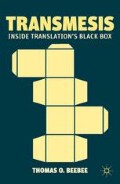Abstract
Were Gayatri Spivak to read Willard van Orman Quine’s Word and Object, or his other relevant writings on translation, she might be compelled to add him, on the basis of his famous “gavagai” example and the transmesis he composes in order to explain it, to her list of the excoriated foundational. That is, the notion of unknown language that calls for “radical translation,” as defined in the epigraph, can be taken as analogous to Kant’s extreme of humanity. The speakers of Jungle, as Quine calls the unknown language that produces a single lexical item, join the New Hollanders and Firelanders at the extreme edge of humanity. What they lack, however, is not material culture— they could, as I will show in what follows, just as well be space aliens trying to explain their incredibly advanced technology to us earthlings—but rather cognates with Western languages, which, as noted above, along with shared culture serve to disguise the indeterminacy of all translation. Quine wishes to use his one-word example to demonstrate the following thesis about translation: “[M]anuals for translating one language into another can be set up in divergent ways, all compatible with the totality of speech dispositions, yet incompatible with one another” (Word and Object 27). The term speech disposition is important, for it encapsulates a behaviorist view of language that linguistic utterances are responses to stimuli from a variety of sources.
It is, no doubt, exceedingly difficult for an outsider, operating inevitably within the world-frame of his own tongue, to penetrate to the active symbolic deeps of a foreign tongue…. Yet careful, philosophically and poetically disciplined observation does allow the linguist and anthropologist to enter, in some degree at least, into the “pattern-system” of an alien tongue. Particularly if he acts on the principles of ironic self-awareness which underlie a genuine relativist view.
—George Steiner, After Babel
Translation between kindred languages, e.g., Frisian and English, is aided by resemblance of cognate word forms. Translation between unrelated languages, e.g., Hungarian and English, may be aided by traditional equations that have evolved in step with a shared culture. What is relevant rather to our purposes is radical translation, i.e., translation of the language of a hitherto untouched people. The task is one that is not in practice undertaken in its extreme form, since a chain of interpreters of a sort can be recruited of marginal persons across the darkest archipelago.
—W. V. O. Quine, Word and Object
Access this chapter
Tax calculation will be finalised at checkout
Purchases are for personal use only
Preview
Unable to display preview. Download preview PDF.
Copyright information
© 2012 Thomas O. Beebee
About this chapter
Cite this chapter
Beebee, T.O. (2012). Unknown Language and Radical Translation. In: Transmesis. Palgrave Macmillan, New York. https://doi.org/10.1057/9781137001016_4
Download citation
DOI: https://doi.org/10.1057/9781137001016_4
Publisher Name: Palgrave Macmillan, New York
Print ISBN: 978-1-349-43351-3
Online ISBN: 978-1-137-00101-6
eBook Packages: Palgrave Literature CollectionLiterature, Cultural and Media Studies (R0)

